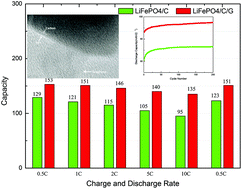当前位置:
X-MOL 学术
›
Dalton Trans.
›
论文详情
Our official English website, www.x-mol.net, welcomes your
feedback! (Note: you will need to create a separate account there.)
Superior lithium-ion insertion/extraction properties of a novel LiFePO4/C/graphene material used as a cathode in aqueous solution
Dalton Transactions ( IF 3.5 ) Pub Date : 2017-08-14 00:00:00 , DOI: 10.1039/c7dt02341c Wenyuan Duan 1, 2, 3, 4, 5 , Mingshu Zhao 1, 2, 3, 4, 5 , Junfang Shen 1, 2, 3, 4, 5 , Suixin Zhao 1, 2, 3, 4, 5 , Xiaoping Song 1, 2, 3, 4, 5
Dalton Transactions ( IF 3.5 ) Pub Date : 2017-08-14 00:00:00 , DOI: 10.1039/c7dt02341c Wenyuan Duan 1, 2, 3, 4, 5 , Mingshu Zhao 1, 2, 3, 4, 5 , Junfang Shen 1, 2, 3, 4, 5 , Suixin Zhao 1, 2, 3, 4, 5 , Xiaoping Song 1, 2, 3, 4, 5
Affiliation

|
Herein, olivine LiFePO4 covered with graphene and carbon layers is prepared via a sol–gel method, followed by calcination, and the resultant composite is used as a cathode material in aqueous rechargeable lithium-ion batteries (ARLBs). The phase structure and morphology of the composite are characterized via X-ray diffraction (XRD), transmission electron microscopy (TEM), high-resolution transmission electron microscopy (HRTEM) and specific surface area analysis (BET). The ARLB system is fabricated using LiFePO4/C/graphene as the cathode and a zinc anode in 1 mol L−1 ZnSO4·7H2O and saturated LiNO3 aqueous solution without dissolved oxygen, which delivers a capacity of 153 mA h g−1 at 0.5C rate. Even at a 50C rate, it maintains a capacity of 95 mA h g−1 after 200 cycles. The excellent rate capabilities show that this cathode material exhibits good electrochemical performance and this novel ARLB has great potential in the fields of energy storage and high power sources.
中文翻译:

新型LiFePO 4 / C /石墨烯材料在水溶液中用作阴极的优异锂离子插入/萃取性能
在此,通过溶胶-凝胶法制备覆盖石墨烯和碳层的橄榄石LiFePO 4,然后进行煅烧,所得复合材料用作水性可充电锂离子电池(ARLB)的正极材料。复合材料的相结构和形态通过X射线衍射(XRD),透射电子显微镜(TEM),高分辨率透射电子显微镜(HRTEM)和比表面积分析(BET)进行表征。以LiFePO 4 / C /石墨烯为阴极,在1 mol L -1 ZnSO 4 ·7H 2 O和饱和LiNO 3中的锌阳极为阳极,制得ARLB系统。不含溶解氧的水溶液,在0.5C速率下的容量为153 mA hg -1。即使在50C的速率下,它在200个循环后仍保持95 mA hg -1的容量。优异的倍率性能表明该阴极材料具有良好的电化学性能,并且该新型ARLB在储能和高功率电源领域具有巨大潜力。
更新日期:2017-09-20
中文翻译:

新型LiFePO 4 / C /石墨烯材料在水溶液中用作阴极的优异锂离子插入/萃取性能
在此,通过溶胶-凝胶法制备覆盖石墨烯和碳层的橄榄石LiFePO 4,然后进行煅烧,所得复合材料用作水性可充电锂离子电池(ARLB)的正极材料。复合材料的相结构和形态通过X射线衍射(XRD),透射电子显微镜(TEM),高分辨率透射电子显微镜(HRTEM)和比表面积分析(BET)进行表征。以LiFePO 4 / C /石墨烯为阴极,在1 mol L -1 ZnSO 4 ·7H 2 O和饱和LiNO 3中的锌阳极为阳极,制得ARLB系统。不含溶解氧的水溶液,在0.5C速率下的容量为153 mA hg -1。即使在50C的速率下,它在200个循环后仍保持95 mA hg -1的容量。优异的倍率性能表明该阴极材料具有良好的电化学性能,并且该新型ARLB在储能和高功率电源领域具有巨大潜力。











































 京公网安备 11010802027423号
京公网安备 11010802027423号